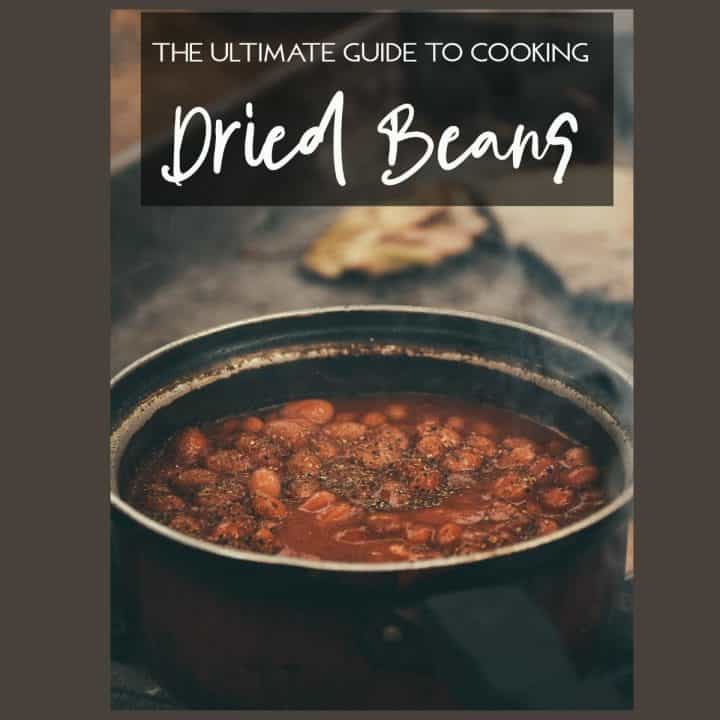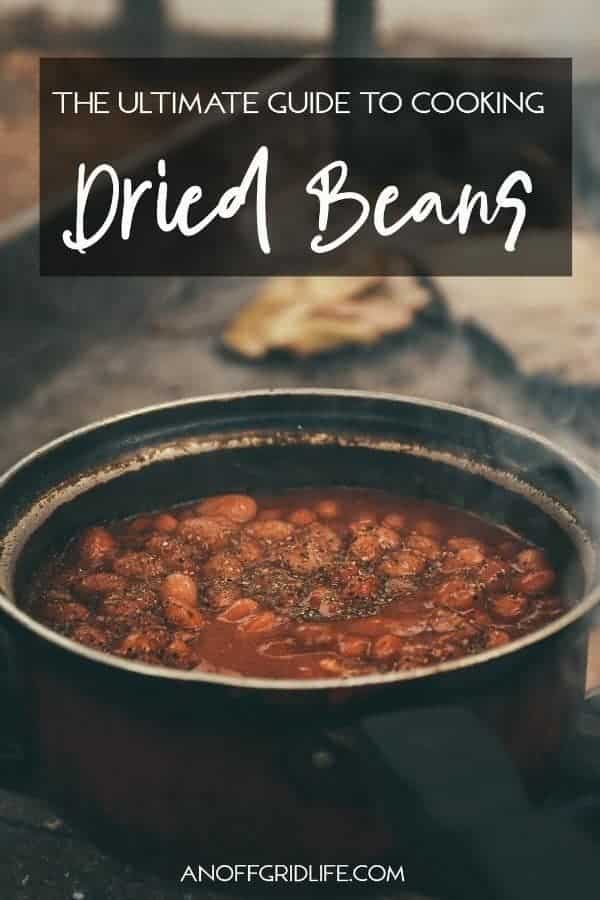Anyone who knows how to cook dried beans will tell you that beans offer a versatile, nutritious, and affordable staple to any pantry. Simple to prepare, cooking your own dried beans also allows you to control the ingredients and sodium content. Learning how to cook dried beans is a wise skill to learn because it will save you money and offer tasty options from your prepper pantry.
Here's everything you need to know about cooking dried beans, from setting the right cooking time to achieving the perfect texture.
Why Add Dried Beans to Long-Term Food Stores?

Cooking frugal, delicious meals doesn't have to be complicated. Take learning how to cook dried beans, for example. Dried beans are:
- Nutritious
- Very inexpensive -a pound of beans can help stretch a meal to feed a large family
- A great side dish to serve with dutch oven chicken recipes or dutch oven ground beef recipes
- A great source of protein
- A good way to add variety to your diet
- versatile - cook them in a slow cooker, an instant pot, on a stove top, in an electric pressure cooker, or the traditional way, in a cast iron dutch oven
A great thing about beans is the wide variety available. There are all sorts of different beans you can buy, and they come in a wide range of colors, shapes, and sizes.
You can find a good bean variety at most grocery stores in the dried food section. Or buy them online from Amazon.
Also, take a look at Rancho Gordo, which offers a wide variety of heirloom beans to plant in your kitchen garden or add to your pantry.
You can also grow enough beans to feed your family. Consider adding heirloom bean varieties to your backyard garden. Or grow beans indoors, like we did one year.
Types of Beans
There are many different types of dried beans to choose from. While they're relatively interchangeable, certain varieties of beans suit certain dishes better than others.
When you know how to cook dried beans using different methods, you'll find you can create many nutritious, tasty, and frugal meals for your family. In fact, I make it a point to look for new bean recipes when menu planning. This month I'm excited to try this Southwest Chili with Black Beans and Corn recipe.
- Kidney beans are hearty, large, and red or white. They're great in many of our favorite recipes, stews, chilis, and soups. Recently I've been experimenting with adding them to our favorite veggie pizza recipe too.
- Pinto beans are similar to red kidney beans, but they're a bit smaller and have a brownish-red color. Pinto beans are often used in Mexican dishes.
- Black beans are small, round, and black. They have a slightly sweet flavor and are often used in Latin American cuisine and recipes like our black bean and ham soup and our chicken salsa black bean casserole.
- Chickpeas, also called garbanzo beans, are beige or tan and have a nutty flavor. This type of bean is popular in Mediterranean dishes.
- Lentils come in various colors, including green, brown, red, and black. They're small, disk-shaped, and have an earthy flavor. Lentils are often used in soups (like our turmeric lentil soup recipe) and salads.
- Black-eyed peas are small, round, and white with a black dot in the center. They're traditionally eaten on New Year's Day for good luck.
- Lima beans are light green, large, and oval-shaped. They have a creamy texture and are often used in stews and soups.
- Cannellini beans are small, white, and kidney-shaped. They have a mild flavor and are often used in soups (try our white bean kale and sausage soup recipe) and salads.
- Great northern beans are medium-sized white beans, smaller than cannellini beans but larger than navy beans. Cook them up with a ham hock or a ham bone for great flavor.
- Navy beans are smaller beans, white, and oval-shaped. They're often used in baked bean dishes, and in soups, like this delicious navy bean and ham soup recipe.
- Split peas are a type of field pea specifically grown to produce yellow or green dried peas.
Preparing Dried Beans for Cooking
Before cooking any variety of dried beans, sort through them in a large bowl. Remove any small stones, twigs, leaves, or bad beans. Then rinse the good dry beans under cool water.
Then they must be soaked in plenty of water in a large pot. This helps them cook evenly and prevents them from absorbing too much water.
There are two ways to soak beans: an overnight soak or a quick soak.
The Overnight Soak
The overnight method is the simplest. Just place the beans in a pot or bowl, cover them with several cups of water, and let them soak for at least eight hours.
The Quick Soak
The quick method is for when you forgot to soak the beans overnight or if you're in a hurry. Place the beans in a pot or bowl, then pour enough water (boiling water) over them and let them soak for one hour. However, if you have larger beans, the short soak might take closer to an hour and a half.
The overnight soaking is ideal - your beans will have a better texture and flavor than with the quick method.
To rinse your beans or not to rinse?
There's a bit of a controversy in the world of dried beans, believe it or not. Some cooks swear by reserving the soaking water to cook the beans in since you are rinsing away some of the starch and flavor by dumping it.
Others prefer to discard the soaking liquid and prefer the flavor and texture of their beans when they use fresh water for the cooking liquid.
Try it both ways and see which way you prefer.
Cooking Dried Beans
After soaking your beans, drain them and place beans in a pot. Cover the beans with cold water, making sure there are about two inches of water above the beans. Depending on the age of the beans, you might find the old beans float to the top. I usually get rid of them.
Sometimes I start soaking beans at night so they're ready for the next day. I often do this with red beans for chili so I can shorten the final cooking process.
Bring the beans to a boil over medium heat, then reduce the heat to a gentle simmer and let them simmer until they're tender. This usually takes about one to two hours.
Watch the Water Level
Keep an eye on the water level - you may need to add more water as the beans cook. I prefer to add already-boiling water from my kettle when I do this, so the temperature stays more consistent during cooking.
When I was learning how to cook dried beans, I was taught to add garlic cloves and a bay leaf to my pot of beans. I've even experimented with adding chicken stock from our meat chickens to make a tasty bean broth.
Once the beans are tender, drain them and add any seasonings you like. This is when I add sea salt or kosher salt and any acidic ingredients such as canned tomatoes. Do not add acidic ingredients to your beans at the beginning of cooking, or you'll wait forever to get tender beans!
If you're making soup or chili, you can add soaked beans right to the soup if you'll be cooking it for a few hours. If you're making a quick soup, it's better to have cooked beans or a can of beans to toss in.
Storing Dried Beans
Dried beans will last for a long time in your pantry. The best way to store them is in an airtight container in a cool, dry place. They'll do alright in a plastic or glass container. Be sure not to introduce water into the container since that can encourage mold growth.
Cooked beans will last in the fridge for up to a week or in the freezer for up to six months. You can always cook large batches weekly to use in multiple recipes - it makes things a lot easier.
Canning Dried Beans
If you enjoy canning, you can certainly can your own cooked dried beans if you like to have them on hand for easy meals. You'll want to use a pressure canner since they aren't acidic enough for hot water bath canning.
The good news is that you can season home-canned beans however you want. You could add lemon juice or bay leaves and save loads of money compared to buying cans of beans at the store.
What to Make with Dried Beans

Now that you know how to cook dried beans, what will you do with them? Here are some ideas:
- Toss cooked beans in a salad for extra protein
- Create a side dish or vegetarian alternative to the main meat dish
- Add various beans to chili and soup
- Make protein-packed white quinoa and navy bean bowl for a filling lunch
- Enjoy a simple plate of rice and pinto beans for dinner
- Make black bean brownies
- You can also use them in any recipe that calls for cooked beans. Blend up chickpeas and make your own hummus to dip crackers or veggies in
- Make bean burgers by forming cooked, mashed beans into patties and frying
- Make your own refried beans by mashing cooked beans with some seasonings
Now that you know all about cooking dried beans, it's time to get in the kitchen and start experimenting. Dried beans are a cheap, healthy, and versatile ingredient that can be used in various recipes. Give some of these ideas a try, or come up with your own creations. The possibilities are endless.





